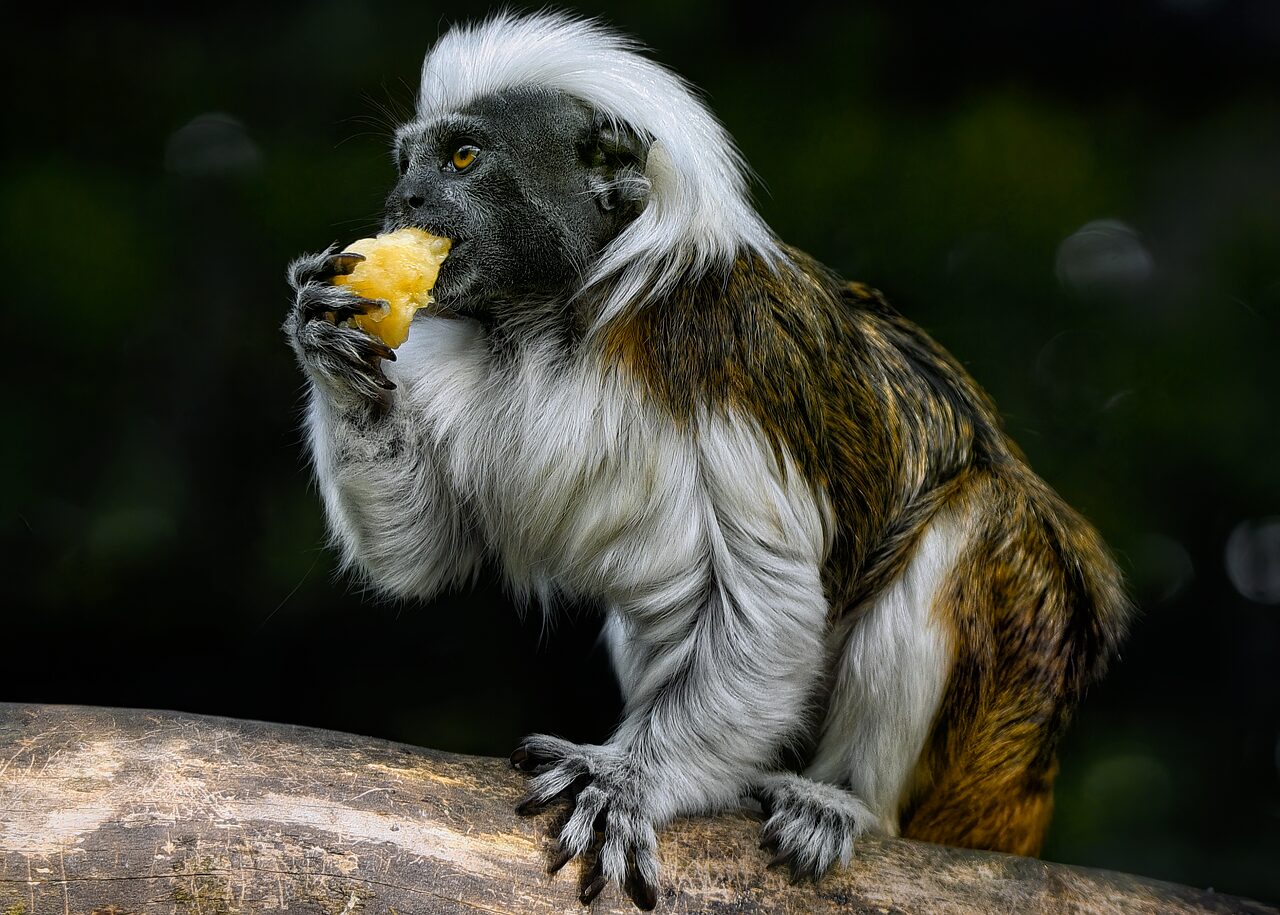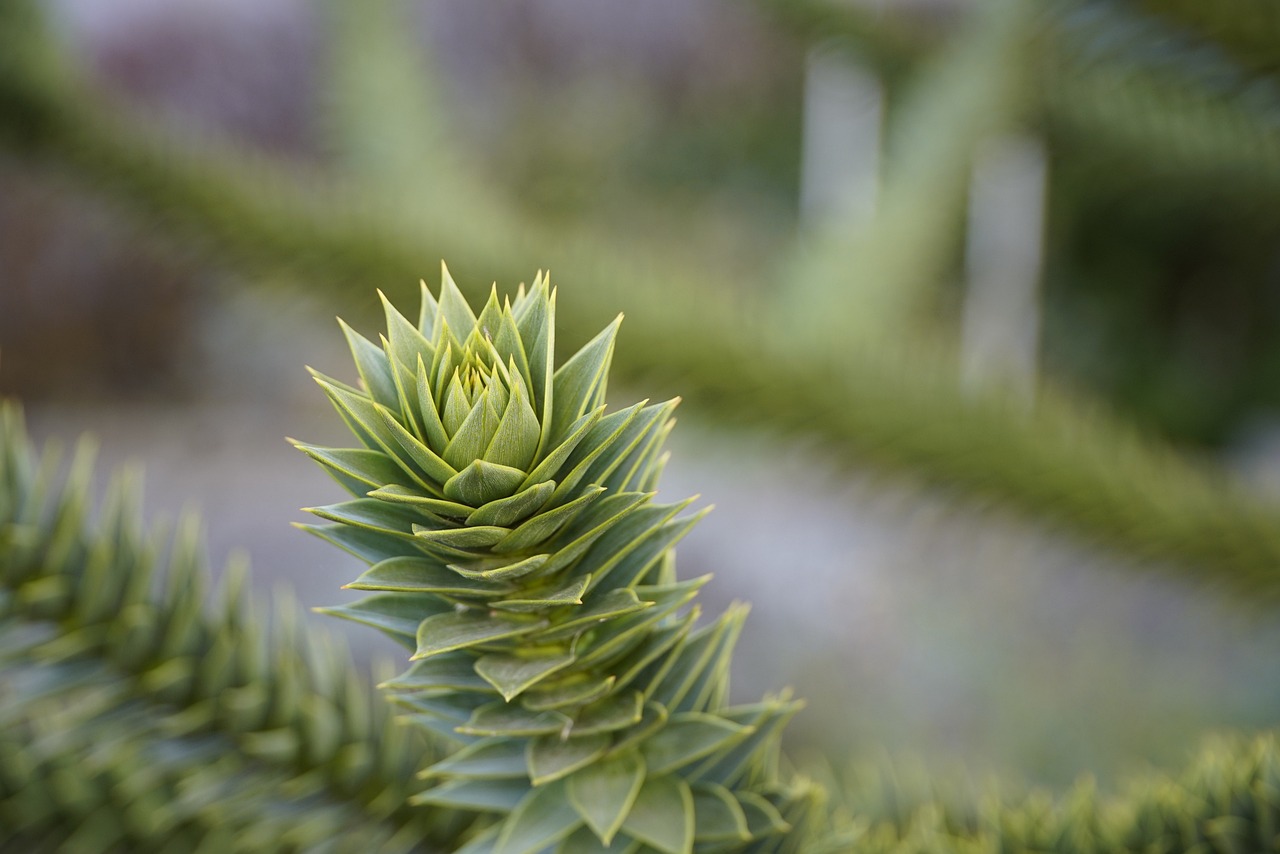The Monkey Puzzle tree, scientifically known as Araucaria araucana, typically grows at a rate of 12 to 24 inches per year under optimal conditions. This unique tree can reach heights of up to 100 feet and thrives in rich, well-draining soil with plenty of sunlight.
Understanding the Monkey Puzzle Tree
The Monkey Puzzle tree is an evergreen conifer native to the southern Andes of Chile and Argentina. Its distinctive appearance, with spiky, whorled branches and thick, scale-like leaves, makes it a favorite among gardeners seeking unique trees. The tree’s unusual name comes from its challenging climbing capabilities; it is said that a monkey would have trouble navigating its spiky branches.

This tree is not only valued for its aesthetic appeal but also for its historical significance. The Monkey Puzzle tree is a protected species in its native habitat, and in many parts of the world, it is cultivated for ornamental purposes. Understanding the growth rate of this tree is crucial for those looking to incorporate it into their gardens.
Optimal Growth Conditions
The growth rate of the Monkey Puzzle tree can be influenced by several factors. To ensure healthy growth, consider the following conditions:
- Soil Quality: Well-draining soil rich in organic matter is essential.
- Sunlight: This tree thrives in full sun but can tolerate partial shade.
- Watering: Regular watering during dry spells encourages growth, but avoid waterlogging.
- Climate: The Monkey Puzzle tree prefers temperate climates and can tolerate moderate frost.
Growth Rate Overview
The average growth rate of the Monkey Puzzle tree varies based on its environment. In ideal conditions, it can achieve substantial growth within a few years. Below is a table summarizing its growth expectations over time:

| Age (Years) | Height (Feet) | Growth Rate (Inches per Year) |
|---|---|---|
| 1 | 1 – 2 | 12 – 24 |
| 5 | 10 – 15 | 12 – 24 |
| 10 | 25 – 30 | 12 – 24 |
| 20 | 60 – 80 | 12 – 24 |
This table illustrates the potential growth trajectory of the Monkey Puzzle tree, emphasizing its ability to thrive over time when provided with suitable care. It is important to note that while some trees may grow faster or slower based on individual circumstances, these numbers serve as a general guideline.
Cultivation Tips
If you decide to grow a Monkey Puzzle tree in your garden, here are some essential tips to encourage healthy growth:
- Select a planting site with adequate space, as these trees can grow quite large.
- Prepare the soil by mixing in compost or well-rotted manure to enhance nutrient content.
- Water regularly during dry periods but ensure good drainage to prevent root rot.
- Consider mulching around the base to retain moisture and suppress weeds.
- Monitor for pests and diseases, as early detection can help maintain tree health.
By following these cultivation tips and understanding the growth rate of the Monkey Puzzle tree, gardeners can successfully incorporate this unique species into their landscapes. This remarkable tree provides not only visual interest but also a conversation piece in any garden setting.

Environmental Factors Affecting Growth
The growth of the Monkey Puzzle tree is heavily influenced by environmental factors. Understanding these elements can help gardeners create the ideal conditions for their trees. Here are some key factors to consider:
Soil Composition
The type of soil plays a vital role in the health and growth rate of the Monkey Puzzle tree. Sandy loam or clay loam soils are preferred as they offer good drainage. Here are some aspects of soil composition to keep in mind:
- pH Level: The ideal pH for the Monkey Puzzle tree is between 6.0 and 7.5. Testing your soil’s pH can help determine if amendments are needed.
- Nutrient Content: Incorporating organic matter, such as compost, can enhance nutrient levels and promote healthy growth.
- Drainage: Ensure that water does not pool around the roots, as this can lead to root rot.
Temperature and Climate
The Monkey Puzzle tree thrives in temperate climates. It is tolerant of some frost but requires specific temperature ranges to grow optimally. Here are some temperature-related tips:

- Ideal Temperature Range: The tree grows best in temperatures between 60°F and 75°F.
- Frost Tolerance: While it can survive light frosts, prolonged exposure to freezing temperatures can damage young trees.
- Heat Sensitivity: High temperatures above 90°F can stress the tree, leading to stunted growth.
Pest and Disease Management
Like any other plant, the Monkey Puzzle tree is susceptible to various pests and diseases. Regular monitoring and preventive measures can help maintain its health. Here are some common issues to be aware of:
Common Pests
Several pests may threaten the health of a Monkey Puzzle tree. Identifying these early is crucial for effective management. Common pests include:
- Aphids: These small insects suck sap from the leaves, leading to yellowing and stunted growth.
- Spider Mites: These tiny pests can cause foliage to appear stippled and discolored.
- Mealybugs: These pests produce a white, cottony substance and can weaken the tree over time.
Disease Concerns
In addition to pests, certain diseases can affect the Monkey Puzzle tree. Some notable diseases include:
- Root Rot: Caused by overly wet soil conditions, root rot can be fatal if not addressed promptly.
- Bark Beetles: These insects bore into the bark, leading to decline in tree health.
- Fungal Infections: Fungi can cause leaf spots and other symptoms that weaken the tree.
Pest and Disease Prevention Strategies
Implementing strategies for pest and disease prevention is essential for maintaining a healthy Monkey Puzzle tree. Consider the following approaches:
- Regular Inspection: Check your tree frequently for signs of pests or diseases.
- Maintain Healthy Soil: Healthy plants are less susceptible to pests and diseases. Focus on good soil management practices.
- Use Organic Treatments: If infestations occur, consider using organic pesticides or insecticidal soaps to control pests.
- Remove Affected Areas: Prune away any diseased or infested branches to prevent further spread.
Varietal Differences in Growth Rate
The growth rate of Monkey Puzzle trees can also vary based on their specific varieties. While Araucaria araucana is the most common, there are other cultivars that may grow differently due to genetic factors. Here are some notable varieties:
| Variety | Description | Growth Rate (Inches per Year) |
|---|---|---|
| Araucaria araucana | The standard variety known for its unique shape and spiky leaves. | 12 – 24 |
| Araucaria angustifolia | A slightly smaller version with a more compact growth habit. | 10 – 20 |
| Araucaria heterophylla | The Norfolk Island pine, known for its softer foliage and faster growth in certain conditions. | 15 – 30 |
This table highlights some variations among different Monkey Puzzle tree varieties. Selecting the right cultivar for your garden can significantly impact growth rates and overall success.
Caring for Your Monkey Puzzle Tree
Caring for a Monkey Puzzle tree involves several important practices to ensure its healthy growth and longevity. These trees require specific attention in terms of watering, fertilization, and pruning. Below, we discuss each aspect in detail.
Watering Requirements
Proper watering is essential for the growth of the Monkey Puzzle tree. Here are some guidelines to follow:
- Young Trees: Newly planted trees require regular watering. Ensure the soil remains moist but not waterlogged.
- Established Trees: Once established, these trees are somewhat drought-tolerant. However, during prolonged dry spells, deep watering is beneficial.
- Signs of Underwatering: Yellowing leaves or wilting can indicate a lack of water.
Fertilization Practices
Fertilizing your Monkey Puzzle tree helps provide essential nutrients that support growth. Here are some tips:
- Type of Fertilizer: Use a balanced fertilizer with equal parts nitrogen, phosphorus, and potassium (N-P-K). Organic options like compost or well-rotted manure are excellent choices.
- Application Timing: Fertilize in early spring before new growth starts. This timing will promote healthy foliage development.
- Frequency: Generally, fertilizing once a year is sufficient unless soil tests indicate otherwise.
Pruning Techniques
Pruning is an essential part of maintaining the health and shape of your Monkey Puzzle tree. Here are some effective pruning techniques:
- When to Prune: The best time to prune is during late winter or early spring when the tree is still dormant.
- What to Remove: Focus on removing dead or damaged branches. This helps improve air circulation and light penetration.
- Shaping the Tree: Consider light shaping to enhance the tree’s appearance, but avoid excessive pruning as this can stress the tree.
Common Mistakes to Avoid
Caring for a Monkey Puzzle tree can be rewarding, but there are common mistakes that gardeners should avoid. Here are some pitfalls to watch out for:
Overwatering
One of the most frequent issues faced by Monkey Puzzle trees is overwatering. Symptoms of overwatering include:
- Soggy soil conditions
- Yellowing leaves
- Root rot
Lack of Sunlight
These trees prefer full sun exposure. Insufficient sunlight can cause weak growth and poor development. Ensure your tree is planted in a location where it receives adequate sunlight throughout the day.
Ignoring Soil Quality
The quality of the soil significantly affects the growth rate of the Monkey Puzzle tree. Avoid planting in compacted or poorly drained soils. Regularly amend the soil with organic matter to improve its structure and nutrient content.
Cultural Significance and Uses
The Monkey Puzzle tree holds cultural significance in various regions, particularly in its native habitat. Additionally, it has several uses that make it a valuable addition to gardens and landscapes.
Cultural Importance
In Chile, the Monkey Puzzle tree is considered a national symbol. The Araucanian people regard it as sacred and use its seeds in traditional dishes. Understanding its cultural background adds depth to cultivating this unique species.
Uses in Landscaping
The Monkey Puzzle tree can serve multiple purposes in landscaping projects:
- Specimen Tree: Its striking appearance makes it an excellent focal point in gardens.
- Shade Tree: As it matures, it provides ample shade, making it suitable for parks and larger yards.
- Wildlife Habitat: The tree attracts birds and insects, contributing to biodiversity in the garden.
Propagation Methods
Propagating Monkey Puzzle trees can be done through seeds or cuttings. Understanding these methods can help gardeners expand their collection.
Seed Propagation
Growing Monkey Puzzle trees from seeds is a common method. Here are the steps involved:
- Seed Preparation: Soak seeds in water for 24 hours before planting to enhance germination rates.
- Sowing Seeds: Plant seeds in well-draining soil at a depth of about one inch.
- Germination Time: Expect germination to take several weeks, requiring consistent moisture and warmth.
Cuttage Method
This method involves taking cuttings from healthy trees. Here’s how to do it:
- Selecting Cuttings: Choose healthy, semi-ripe cuttings from new growth.
- Treatment: Dip cut ends in rooting hormone to encourage root development.
- Planting: Place cuttings in a well-drained potting mix and keep them moist until roots develop.
By understanding these propagation methods, gardeners can cultivate their own Monkey Puzzle trees and enjoy their unique beauty in various settings.
Maintenance and Long-Term Care
Maintaining a Monkey Puzzle tree requires ongoing care to ensure that it continues to thrive as it matures. Regular maintenance will help prevent issues and promote optimal growth.
Mulching
Applying mulch around the base of the tree can provide several benefits:
- Moisture Retention: Mulch helps retain soil moisture, reducing the need for frequent watering.
- Weed Suppression: A good layer of mulch can prevent weeds from competing with the tree for nutrients.
- Temperature Regulation: Mulch maintains a consistent soil temperature, which is vital for root health.
Seasonal Care
Seasonal changes can impact the care required for Monkey Puzzle trees. Here are some tips to consider based on the seasons:
- Spring: This is a critical time for fertilization and ensuring that the tree receives adequate water as new growth begins.
- Summer: Monitor for pests and diseases, and ensure the tree is not under stress from heat or drought.
- Autumn: As leaves drop, it’s a good time to clean up debris to prevent fungal diseases.
- Winter: Protect young trees from severe frost by covering their bases with mulch or burlap.
Benefits of Growing Monkey Puzzle Trees
The decision to incorporate Monkey Puzzle trees into your garden offers numerous advantages beyond their striking appearance. Here are some key benefits:
Aesthetic Appeal
The unique structure and foliage of the Monkey Puzzle tree make it an eye-catching addition to any landscape. They can complement various garden styles, from formal to naturalistic settings.
Environmental Contributions
Planting these trees can enhance local ecosystems by providing habitats for wildlife. Birds, insects, and other creatures may find refuge in its branches, contributing to biodiversity.
Cultural and Historical Significance
The significance of the Monkey Puzzle tree extends beyond mere aesthetics. Its historical context and cultural importance provide depth to its presence in gardens, connecting gardeners with nature’s heritage.
Challenges in Growing Monkey Puzzle Trees
While there are many benefits to growing Monkey Puzzle trees, potential challenges must also be considered. Being aware of these can help you prepare better:
Slow Growth Rate
Although they can grow a foot or two each year, some gardeners may find this slow compared to faster-growing species. Patience is essential when cultivating Monkey Puzzle trees.
Space Requirements
As these trees mature, they require considerable space. Ensure your planting area accommodates their eventual height and spread to avoid overcrowding other plants.
Final Thoughts
The Monkey Puzzle tree is a distinctive and valuable addition to any garden. Its impressive growth rate, unique appearance, and environmental contributions make it an attractive choice for gardeners seeking something different. By understanding the specific needs and maintenance practices of this tree, gardeners can enjoy its beauty for generations.
Cultivating a Monkey Puzzle tree can also serve as a rewarding experience, connecting individuals with nature while providing aesthetic value and ecological benefits. Whether you choose to propagate from seeds or cuttings, your efforts will contribute to the preservation of this remarkable species. With proper care and attention, these trees can thrive, creating stunning landscapes that endure through time.
In conclusion, embracing the growth journey of the Monkey Puzzle tree allows gardeners to witness its transformation from a small seedling to a majestic specimen. As they flourish, these trees not only enhance our gardens but also tell stories of resilience and beauty inherent in nature.
